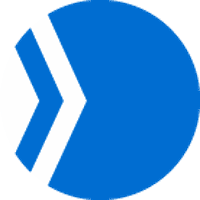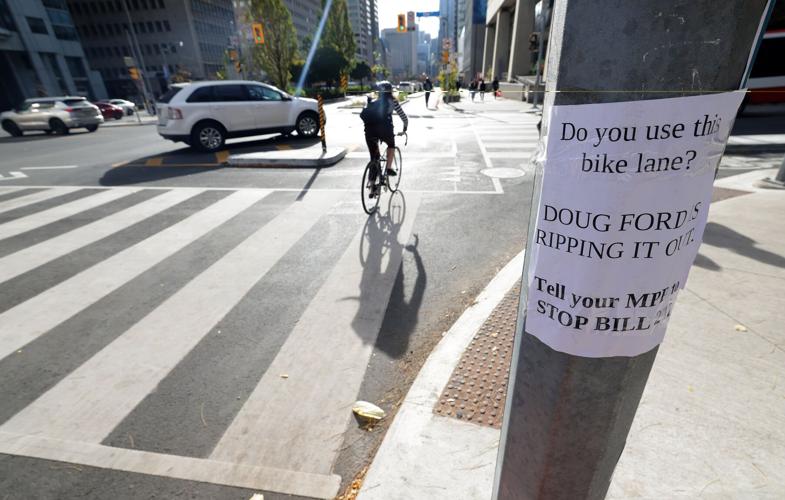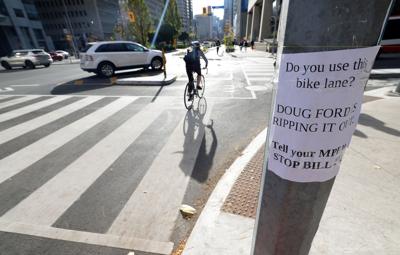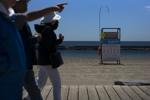Premier Doug Ford‘s months-long campaign against several …´…´¿≤¬Ýbike lanes was dealt a serious setback Wednesday when a judge ruled their removal would be unconstitutional.
A decision by Superior Court Justice Paul Schabas found that sections of the Ontario government’s Bill 212,¬Ýthe Reducing Gridlock, Saving You Time Act, violated the Charter by infringing on cyclists’ rights to life and security of person. Part of the bill, which became law in November, calls for the removal of protected bike lanes on Yonge, University and Bloor Streets.
The Charter challenge of that plan was launched¬Ýby cycling advocates, including Cycle…´…´¿≤, in December.
The government said it will appeal the court’s decision.
“We were elected by the people of Ontario with a clear mandate to restore lanes of traffic and get drivers moving by moving bike lanes off of major roads to secondary roads,”¬Ýa spokesperson for Transportation Minister Prabmeet Sarkaria said.
What was in the bike lane decision?
In his decision, Schabas found that “the government has led no evidence to rebut the applicants’ compelling position, supported by evidence, that removing the protected bike lanes will cause cyclists to ride in more dangerous mixed traffic ‚Ķ and that cyclists will be injured, and worse, if the protected target bike lanes are removed.”¬Ý
The decision does not guarantee¬Ýthe right to a bike lane, nor does it prevent the Ford government from blocking any new bike lanes from being built, Schabas explained in his ruling.
“The government has the right to make decisions about roads and traffic infrastructure,” Schabas wrote, “but where the government takes action that puts people at risk, and does so arbitrarily, its actions may be restrained by the Charter.”
The Ford government had attempted to work around the Charter challenge, changing the legislation in June from “the Minister shall remove the bicycle lanes located on Bloor Street, University Avenue and Yonge Street,” to “the Minister shall restore a lane for motor vehicle traffic on Bloor Street, University Avenue, Avenue Road, and Yonge Street, in the City of …´…´¿≤, by reconfiguring the bicycle lanes.”
Schabas did not buy the argument from the government that this would render the Charter challenge moot.
“I find that any ‘reconfiguring’ which has the effect of removing the physical separation of the target bike lanes from motor vehicle traffic for the purpose of reducing congestion is also a breach of the Charter,” he wrote.
“It is reasonable to conclude that people who cycle will be injured and killed when lanes for motor vehicles are installed and protected bike lanes are removed,” he added.
Schabas pointed to expert evidence, presented by both the government and the cycling advocates, that removal of the bike lanes would “substantially increase the number of collisions for all road users and will not achieve the objective of reducing congestion.”
Schabas also ordered the government to pay $200,000 in legal fees to the cycling advocates and their legal team.
What happens now?
The Ford government’s appeal will go to the Ontario Court of Appeals.
It also has the option of using the notwithstanding clause, which it controversially used in 2021¬Ýin an attempt to restrict third-party advertising and in 2022¬Ýto pre-emptively prevent an education worker strike.
Michael Longfield, executive director of Cycle…´…´¿≤, called Schabas’s ruling on Wednesday a “major victory.”
“I think it’s maybe a good moment for the premier to stop and reconsider,” Longfield said. ”(Canada is) facing an unprecedented trade war and I think there are other things we need the premier of Ontario focused on and working on rather than obsessing over 19 kilometres of bike lanes and meddling with local politics in Ontario.”
The Ford government had previously opened the door to finding a¬Ýcompromise with the city to reintroduce vehicle lanes on Bloor, University and Yonge streets without removing protected bike lanes.
The city is “reviewing the court decision and the impact on our ongoing discussions with the province,” a spokesperson for Mayor Olivia Chow said in a statement.¬Ý
“Mayor Chow maintains that the city of …´…´¿≤ and its elected council should be the ones making decisions about municipal infrastructure,” the spokesperson added.
Why the Ford government targeted bike lanes
The premier and his government campaigned on removing bike lanes in …´…´¿≤‚Äôs downtown core¬Ýduring February’s election. The provincial government argued that road space dedicated to cyclists was taking away road space from drivers and cyclists should instead be diverted to ‚Äúsecondary roads.‚Äù
Bike lane users Eva Stanger-Ross and Narada Kiondo and¬ÝCycle …´…´¿≤¬Ýfiled their Charter challenge with the Superior Court in December, arguing that the new law ‚Äúputs lives at risk.‚Äù
Schabas granted a temporary injunction in April, preventing the province from removing the lanes while he decided on the Charter case. The province’s appeal of that injunction was¬Ýrejected by a panel of three Superior Court judges¬Ýon July 9.
Government documents released as part of the injunction hearing warned that removing the bike lanes may not ease congestion, and instead could increase the risk of collisions and negatively impact businesses.
Ford had previously scolded "unelected judges"¬Ý‚Äî¬Ýtaking aim at Schabas ‚Äî when the bike lane removals were blocked by the injunction, and floated the idea of electing judges to the bench. Those comments earned him a rare rebuke from the province's top justices, who reaffirmed the need for judicial independence.
“Judges should not determine items like bike lanes … because of ideology, they decide to put an injunction in,” the premier said at a press conference in May.
“Enough is enough.”
































To join the conversation set a first and last name in your user profile.
Sign in or register for free to join the Conversation